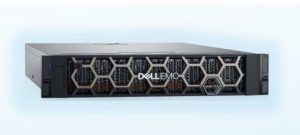 INFRA
INFRA
 INFRA
INFRA
 INFRA
INFRA
Calling the PowerStore storage product line it introduced last year “the fastest-ramping new architecture in our company’s history,” Dell Technologies Inc. today is refreshing the product with improved speed and automation and also introducing a low-cost entry port starting at $28,000.
Dell has had high expectations for PowerStore to jumpstart its growth in the midrange market, which has been flat for some time. Among its chief innovations was the ability to support a wide range of block and file workloads, the use of the high-speed NVMe communications protocol and storage-class memory, as well as an integrated VMware Inc. hypervisor called AppsON that enables applications to run directly on the storage array.
Executives said PowerStore’s success, with more than 400 petabytes of capacity shipped in the past 11 months, contributed to 8% percent growth in the latest quarter “largely on the backs of PowerStore,” said Travis Vigil, senior vice president of product management at Dell EMC.
The highlight of today’s update is an upgrade to the PowerStoreOS operating software that delivers performance improvements and increased intelligence across the platform. Dell is also introducing PowerStore 500 (pictured, below), a low-end entry that can be clustered with other PowerStore models.

Dell PowerStore 500, Photo: Dell Technologies
PowerStoreOS 2.0 delivers across-the-board speed improvements of up to 25% on mixed workloads and 65% on high-volume write operations across every PowerStore model. New support for NVMe over Fibre Channel takes advantage of parallel operations to make the performance of external arrays approach those of direct-attached storage, officials said. Users can continue to run Fibre Channel and SCSI protocols over the same fabric.
Improvements to AppsON enable users to move virtual machines and applications freely on clustered appliances, a feature that’s especially useful in edge computing and distributed analytics scenarios, said Jon Siegal (pictured), a Dell EMC product marketing vice president. AppsON uses virtual volumes, an integration and management framework that virtualizes storage arrays. A single stretched vVol container can be used across appliances to present a single pool of storage to all nodes.
“This allows customers to consolidate even more storage-intensive workloads at the edge or even running big-data analytics applications that benefit from running on the array directly,” Siegal said.
Improved intelligence in the operating system improves both data reduction rates and recovery from disk failures. Dell now guarantees a four-to-one data reduction ratio through intelligent de-duplication and compression. The de-duplication cache size is now dynamic and automatically configured based on capacity to increase overall data reduction. Automated capacity and performance management deliver what the company said is up to 20% more input/output operations per second during peak bursts.
Enhancements to Dell’s Dynamic Resiliency Engine enable support for single- or dual-parity redundancy to meet whatever availability requirement customers have, including protection against simultaneous multi-drive failures, the company said. The software intelligently varies rebuild speeds to accommodate changing workloads and requires significantly less management effort than conventional RAID.
“It automates all the complex processes associated with drive configuration, as well as redundancy and tiering, for up to 98% less management effort compared with traditional RAID subsystems,” Siegal said. “Everything’s handled by the intelligence software itself, right down to replenishing capacity if a drive fails.”
The addition of metadata tiering enables SCM and flash storage to be combined in the same chassis with PowerStore directing metadata to the higher-performing layer automatically. “This means that customers can now use SCM drives as a high-performance layer with as little as one drive for metadata access and reduce workload latency by up to 15%,” Siegal said. “This is ideal for active data sets where data moves out of the cache quickly.”
The new entry-level PowerStore 500 delivers 1.2PB of capacity in a 2u device with full support for all PowerStore OS 2.0 features. A single device can support up to 1,500 virtual desktops or 2.4 million SQL transactions per minute, the company said.
Up to four of the devices can be clustered to achieve 4.8PB of storage. They can also be mixed with other models in the PowerStore line to reach 9.8PB capacity. Adding in the PowerStore metro node, which was introduced last year, enables synchronous replication across metro distances.
“This offers synchronous replication in mobility over metro distances and allows the PowerStore 500 to participate in distributed enterprise solutions, as well as disaster recovery scenarios,” Siegal said.
The software enhancements and PowerStore 500 array will be generally available on June 10.
Support our mission to keep content open and free by engaging with theCUBE community. Join theCUBE’s Alumni Trust Network, where technology leaders connect, share intelligence and create opportunities.
Founded by tech visionaries John Furrier and Dave Vellante, SiliconANGLE Media has built a dynamic ecosystem of industry-leading digital media brands that reach 15+ million elite tech professionals. Our new proprietary theCUBE AI Video Cloud is breaking ground in audience interaction, leveraging theCUBEai.com neural network to help technology companies make data-driven decisions and stay at the forefront of industry conversations.